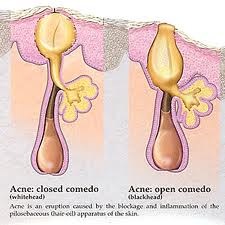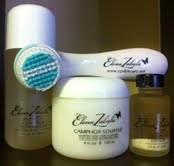What is Acne?
WHAT IS ACNE?
 Acne vulgaris, commonly known as acne, is a disorder of the hair follicle or pore and is the most common skin disease. It is classified as a chronic inflammatory disease of the skin.
Acne vulgaris, commonly known as acne, is a disorder of the hair follicle or pore and is the most common skin disease. It is classified as a chronic inflammatory disease of the skin.
Acne is distinguished by the presence of pimples or “zits”, whiteheads and blackheads. It affects the face, neck, chest, back, and upper arms of sufferers. Acne varies from very mild to extremely severe.
Acne most frequently effects teens and preteens and affects both sexes equally. However, adults are absolutely not immune to acne. Many women and men suffer from adult onset acne. Acne can also show in babies, toddler and small children.
Moderate and severe inflammatory types of acne result after the plugged follicle is invaded by Propionibacterium acnes, bacteria that normally live on the skin. A pimple forms when the damaged follicle weakens and bursts open and releases sebum, bacteria, and skin and white blood cells into the surrounding tissues. Inflamed pimples close to the skin’s surface are called papules. Deeper inflamed pimples are called pustules. The most severe type of acne consists of closed sacs, known as cysts and nodules (hard swellings). Scarring occurs when new skin cells are formed to replace the older, damaged cells
Cleanse Twice a Day
The face has more oil-producing glands than any other parts of the body, says Carolyn Jacob, MD, a Chicago-based dermatologist. Top that with a day’s worth of makeup, sweat, smog, dust, and dirt, and you’re left with a pore-clogging concoction that, if not washed away regularly, will seep into and clog pores, resulting in blackheads and pimples. Even if you don’t shower twice a day, it’s important to cleanse your face in the morning and at night. Look for cleansers that say “noncomedogenic” on the bottle and wash your face thoroughly — and gently — every a.m. and p.m
Exfoliate
Sure, overzealous oil glands can lead to breakouts, but so can under-performing oil glands. Dry skin has tiny cracks in which bacteria can breed, plus excessive flaking can lead to clogged pores. The fix: Gently exfoliate skin a few times a week with a scrub designed for the face, and follow up with a noncomedogenic (there’s that word again) moisturizer.
Say ‘Yes’ to SPF
 You may be apprehensive about slathering SPF on your face because you’ve noticed that after a day in the sun (after getting “sun-kissed) your complexion looks clear and breakout-free. But you’re playing with fire on all fronts. The sun dries out skin, hence the less-oily/pimpled complexion. And if you get burned, the inflammation aggravates acne lesions and pores, potentially leading to worsening acne.
You may be apprehensive about slathering SPF on your face because you’ve noticed that after a day in the sun (after getting “sun-kissed) your complexion looks clear and breakout-free. But you’re playing with fire on all fronts. The sun dries out skin, hence the less-oily/pimpled complexion. And if you get burned, the inflammation aggravates acne lesions and pores, potentially leading to worsening acne.
It’s important to wear SPF each and every time you’re in the sun. Read the ingredients list on the back of your sunscreen, and if you’re acne-prone, look for the lighter, non-occlusive chemical ingredients like avobenzone, oxybenzone, methoxycinnamate, or octocylene. Sunscreens containing zinc oxide or titanium oxide tend to be thicker and sometimes more likely to block pores and aggravate acne-prone skin. If you have acne, look for “noncomedogenic” on the label, which means it should not clog your skin’s pores.



